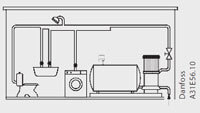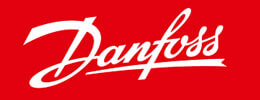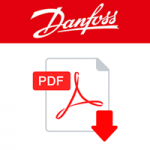
Pressure control for air and water Type CS
CS pressure controls have a built-in pressure operated, three-pole switch. The contact position of which depends on the pressure in the connector and the range setting and adjustable differential. The pressure controls are fitted with a manual switch that will lock the contact system in the open position independently of the pressure in the system. Pressure controls with relief valve is used in compressed air systems where pressure relief on the compressor piston
before start is required. The CS is suited for automatic start and stop of air compressors and water boosters.
 Features
Features
- Pressure ranges 2 – 20 bar,
- Pressure connection G 1/2 or G 1/4,
- Contact system 3-pole (TPST) as standard and 1-pole as accessory,
- Adjustable differential,
- Relief valve as accessory,
- Manual switch to lock the contact system,
- Enclosure IP43 or IP55,
- Special versions with pressure connection made of polyacetal suitable in drinking water applications.
Approvals
- EN 60 947-4-1
- EN 60 947-5-1
China Compulsory Certificate, CCC
Technical data

| Specifications | ||
|---|---|---|
| Contact load | Ie | Ue |
| AC-3 | 12 A | 220 – 415 V |
| AC-3 | 9 A | 600 V |
| DC-13/ 14 | 2 A | 220 V (3 contacts in series) |
| Electrical life on rated load | 100.000 operations | |
| Mechanical life | 1.000.000 operations | |
| Ambient temperature | -20 – 70 °C | |
| Temperature of medium | Water | 0 – 70 °C |
| Temperature of medium | Air | -20 – 70 °C |
| Vibration-proof | 0 – 1000 Hz at 4g | |
| Resonance frequency | Direction A-B | 341 Hz |
| Resonance frequency | Direction C-D | 332 Hz |
| Resonance frequency | Direction E-F | 488 Hz |
| Diaphragm material | Hytrel | |
| Pressure connector | Special | Polyacetal, G ½ |
| Pressure connector | Others | Silumin, G ¼ or G ½ |
Properties according to EN 60947
| Wire dimension | solid / stranded | 0.7 – 2.5 mm2 |
| Wire dimension | flexible, with / without ferrules | 0.75 – 2.5 mm2 |
| Wire dimension | flexible, with ferrules | 0.5 – 1.5 mm2 |
| Tightening torque | max. 1.2 NM | |
| Rated impulse voltage | 4 kV | |
| Pollution degree | 3 | |
| Short circuit protection, fuse | 25 A | |
| Insulation | 600 V | |
| IP-index | IP43 or IP55 |
Ordering

Standard pressure switch type CS
| Stop pressure pe [bar] | Min. differential Δp [bar] | Max. differential Δp [bar] | Max. test pressure pe [bar] | Grade of enclosure | Pressure connection | Code no. | Type |
|---|---|---|---|---|---|---|---|
| 2 – 6 | 0.72 – 1.0 | 1.0 – 2.0 | 10 | IP43 | G ¼ | 031E020266 | 1-pole |
| 2 – 6 | 0.72 – 1.0 | 1.0 – 2.0 | 10 | IP43 | G ¼ | 031E020066 | 3-pole |
| 2 – 6 | 0.72 – 1.0 | 1.0 – 2.0 | 10 | IP55 | G ¼ | 031E020566 | 3-pole |
| 2 – 6 | 0.72 – 1.0 | 1.0 – 2.0 | 10 | IP43 | G ½ | 031E021066 | 3-pole |
| 2 – 6 | 0.72 – 1.0 | 1.0 – 2.0 | 10 | IP55 | G ½ | 031E021566 | 3-pole |
| 4 – 12 | 1 – 1.5 | 2.0 – 4.0 | 20 | IP43 | G ¼ | 031E022066 | 3-pole |
| 4 – 12 | 1 – 1.5 | 2.0 – 4.0 | 20 | IP55 | G ¼ | 031E022566 | 3-pole |
| 4 – 12 | 1 – 1.5 | 2.0 – 4.0 | 20 | IP43 | G ½ | 031E023066 | 3-pole |
| 4 – 12 | 1 – 1.5 | 2.0 – 4.0 | 20 | IP55 | G ½ | 031E023566 | 3-pole |
| 7 – 20 | 2 – 3.5 | 3.5 – 7.0 | 32 | IP43 | G ¼ | 031E024066 | 3-pole |
| 7 – 20 | 2 – 3.5 | 3.5 – 7.0 | 32 | IP55 | G ¼ | 031E024566 | 3-pole |
| 7 – 20 | 2 – 3.5 | 3.5 – 7.0 | 32 | IP43 | G ½ | 031E025066 | 3-pole |
| 7 – 20 | 2 – 3.5 | 3.5 – 7.0 | 32 | IP55 | G ½ | 031E025566 | 3-pole |
Preferred version
Special versions with Polyacetal pressure connection – suitable for drinking water
| Stop pressure pe [bar] | Min. differential Δp [bar] | Max. differential Δp [bar] | Max. test pressure pe [bar] | Grade of enclosure | Pressure connection | Code no. | Type |
|---|---|---|---|---|---|---|---|
| 2 – 6 | 0.72 – 1.0 | 1.0 – 2.0 | 10 | IP43 | G ½ | 031E101066 | 3-pole |
| 4 – 12 | 1 – 1.5 | 2.0 – 4.0 | 20 | IP43 | G ½ | 031E101266 | 3-pole |
| 7 – 20 | 2 – 3.5 | 3.5 – 7.0 | 32 | IP43 | G ½ | 031E101466 | 3-pole |
Accessories and spare parts
| Description | Code no. |
|---|---|
| Three pole contact system (TPST) | 031E029166 |
| Pressure relief valve, incl. fixing screw (for 6 mm pipe / hose) | 031E029866 |
| Pressure relief valve, incl. fixing screw (for in. pipe / hose)1/4 | 031E029766 |
| Two Pg 16 screwed cable entries with gaskets (cable diam. 6.5 – 15 mm) | 031E029366 |
| Nipple with 7/16-20 UNF and M10 x 1 int. | 031E029666 |
Design / Function
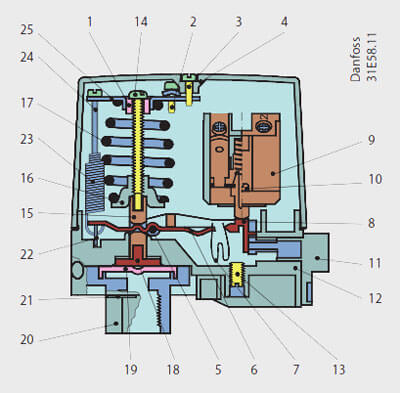 1. Slide ring
1. Slide ring
2. Earth screw
3. Cover screw
4. Cover
5. Spindle
6. Toggle arm
7. Snap spring
8. Snap arm
9. Switch housing ass’ 10. Self-tapping screw
11. Manual switch
12. Base
13. Grubscrew
14. Stop pressure screw
15. Pressure pad
16. Spring retainer
17. Compression spring
18. Pressure shoe
19. Diaphragm
20. Flange, G ¼ or G ½
21. Cap
22. Differential arm
23. Tension spring
24. Differential pressure
screw
25. Bracket
The pressure switch is built up of the following main elements: connector, diaphragm, snap system, main spring, differential spring and a 3-pole or one-pole contact system. The stop pressure must be set on the main spring and the difference between start and stop pressures on the differential spring.
Pressure from the controlled system is led, via the connector, to the diaphragm. The diaphragm converts this pressure to a mechanical movement which is transferred by the snap system to the contact system. In this way, the contact system starts or stops a compressor/pump.
Setting
Note!
If the differential is set at a value greater than the stop pressure the plant cannot start. If this is the case, set the differential at a smaller value (towards minus).
All standard versions of CS pressure controls are preset and supplied with springs under minimum compression.
 1. Turn the stop pressure screw (1) the given number of times towards + (high stop pressure), see stop pressure graph.
1. Turn the stop pressure screw (1) the given number of times towards + (high stop pressure), see stop pressure graph.
2. Turn the differential screw (2) the given number of times towards + (max. differential), see differential pressure
nomogram.
3. Start the plant and let it run until the required stop pressure is reached.
4. Turn the stop pressure screw (1) towards minus (lower stop pressure) until the plant stops.
5. Reduce the pressure to the required start pressure.
6. Turn the differential screw (2) towards minus (smaller differential) until the plant starts.
7. Check that the plant stops and starts at the required pressures.
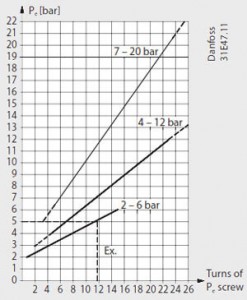 Stop pressure graph
Stop pressure graph
Example
A compressor is to be regulated by a CS pressure switch. The start pressure is 3.5 bar, and the stop pressure 5 bar. The choice should be a CS with a range of 2 – 6 bar.
1. Turn the stop pressure screw (1) about 12 times. See cut-off pressure graphs.
2. Turn the differential screw (2) about 4.5 times. See CS 2 – 6 nomogram.
Take a straight line from 5 bar stop pressure on the nomogram to the differential, 1.5 bar and read off the number of turns, i.e. 4.5.
Mains connection
3-pole
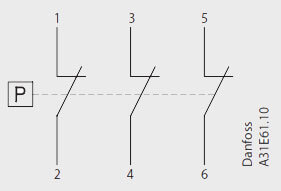
1-pole a.c. load
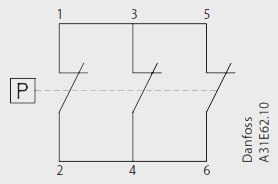
1-pole d.c. load

| Contact load | Ie | Ue |
|---|---|---|
| AC-3 | 12 A | 220 – 415 V |
| AC-3 | 9 A | 600 V |
| DC-13/ 14 | 2 A | 220 V (3 contacts in series) |
Dimensions [mm] and weights [kg]
Net weight approx. 0.5 kg

Installation
 Recommended orientation
Recommended orientation
The pressure switches will operate regardless of their orientation. However, to meet the enclosure requirements of IP43 and IP55, they must be mounted vertically with the connection downwards. The CS pressure switches are
self-supporting (on the connection).
Fitting a pressure relief valve
1. Remove the blanking plug
2. Fit the pressure relief valve
3. Fit the plastoform screw
Fitting screwed cable entries
The accessory bag contains two sets of metal gaskets each with different internal diameters. These will give a sufficient cord relief if used correctly with the cable diameter concerned.
 Drain hole
Drain hole
If because of large temperature variations there is a risk of condensate forming in the pressure switch, a screwdriver can be used to make a drain hole in the enclosure.
Differential pressure nomograms
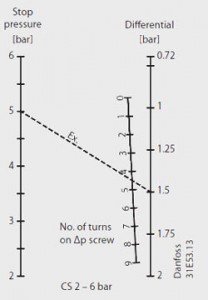
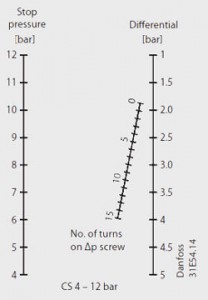
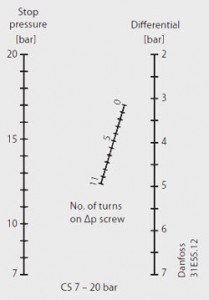
Application examples
A: Motor starter or automatic star-delta switch
Example 1
Control of an air compressor with a CS pressure switch.

Example 2
Control of a compressor with a CS pressure switch fitted with pressure relief valve. Note the check valve between pressure relief line and reservoir.
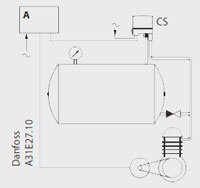
Example 3
Control of an air compressor with a CS. An EV210B 3B solenoid valve is recommended where there is need for especially fast pressure relief.

Example 4
4 Control of a centrifugal pump with a CS, via an automatic star-delta switch, motor starter, or similar.

Example 5
Pressure boosting system for domestic circuits.A type CS switch is used to start/stop the pump.
